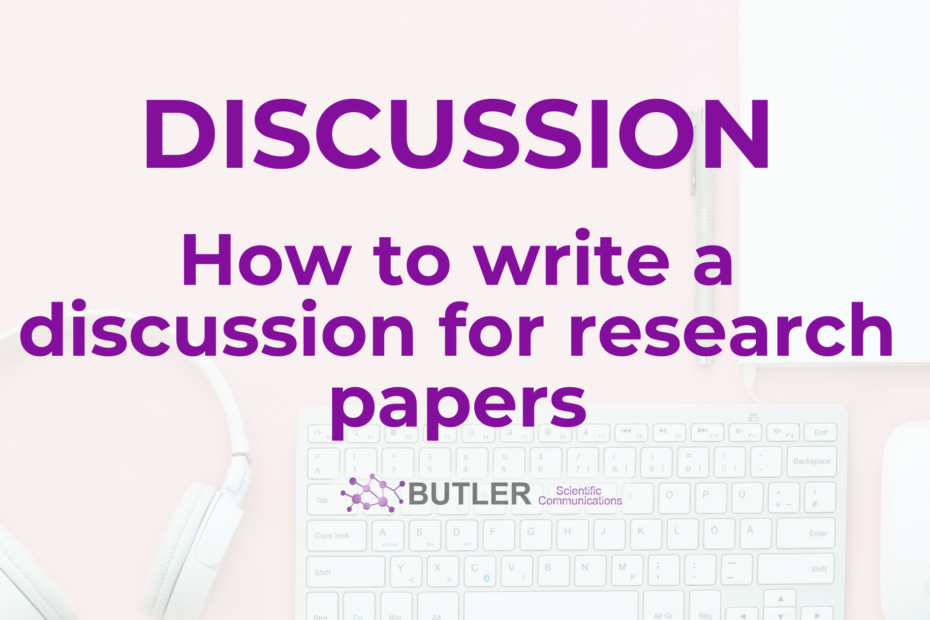Get ready for the most comprehensive overview you’ll ever find for how to write DISCUSSION in a research paper!
Whatever your experience, I guarantee you’ll find something in this post that simplifies writing your next discussion!
Learn the key parts of your discussion and how they fit together into 3 major sections that ensure the reader can see why your work is important and deserves to be published.
This is an updated version (both in terms of examples and content!) of my 2019 tutorial that you can find here for another example of a great discussion section.
Video: How to write DISCUSSION in research paper
Prefer a video?
We’ve got you covered! Check out the video tutorial here (and to hear what a mouse sewing himself a little blue jacket has to do with your discussion):
Parts of a discussion
To start, we’re going to look for 6 key parts in a discussion section, colored according to the chart and descriptions below.
Note the shade of color indicates the “scope” (or accessibility) of that part of the paper:
- Lightest shade indicates narrowest scope (understood best by experts in your field)
- Darkest shade indicates broadest scope (most understandable by a wide audience)
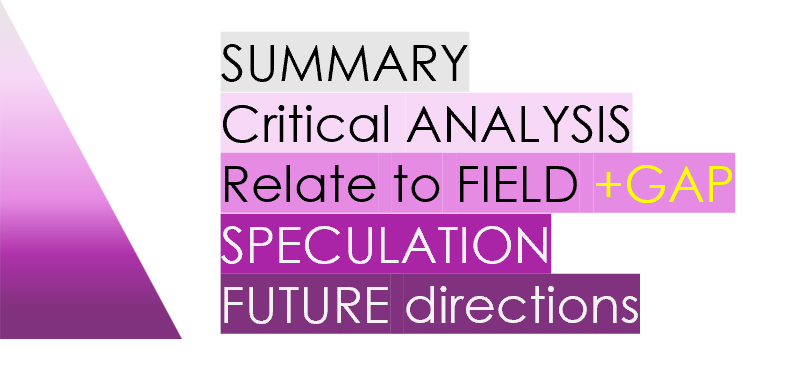
SUMMARY of results
- Reminds reader of key results of your work
Critical ANALYSIS of results
- Highlight all trends, relationships, and limitations
- “Translates” experimental output into meaning/significance
- The reader may not know what the output of an experiment MEANS. Thus, we want to ensure they know what it tells you.
NOTE: I recommend including study limitations within individual paragraphs discussing that work and NOT together at the end.
This is because combining the negative aspects of the study in one place at the end:
- keeps that in the reader’s head at the end and
- gives less room to expand on details and future directions for addressing this.
Relationship to FIELD
- Shows how your results fit into the field as a whole
- Reference related work and highlight conflicting/supporting papers
Relationship to GAP
- Relates your results to the edge of knowledge in the field, i.e., research GAP!
SPECULATE beyond current knowledge
- Speculate about what this means for field or new hypotheses/questions that can be made/asked
- Highlight how the edge of knowledge has changed now that your work exists
FUTURE directions
- Future studies that can address new hypotheses or limitations to your current study
In our discussion, we want to remember that our work is only one tiny dot in our field, and our field is only one tiny dot in the world as a whole. So we need to provide the reader sufficient context to see how our work relates to the field and beyond.
We can see how the different parts of a discussion orient our work within our field and beyond to demonstrate how we want to use them to create a discussion that places our work in context for our reader.

Outline of a DISCUSSION section
Think of your research paper as an hourglass.
If the introduction of the paper starts at a broadly accessible problem and narrows into your research, your discussion has to form the bottom of that hourglass to bring the reader back out from the narrow scope of your research.
Thus, our discussion must relate our work back out to the field as a whole and beyond.
If you want to read a bit more about that hourglass shape before moving on, check out this post about the structure of your research paper.
Otherwise, let’s look more closely at how we can structure our discussion to do make this scope change:
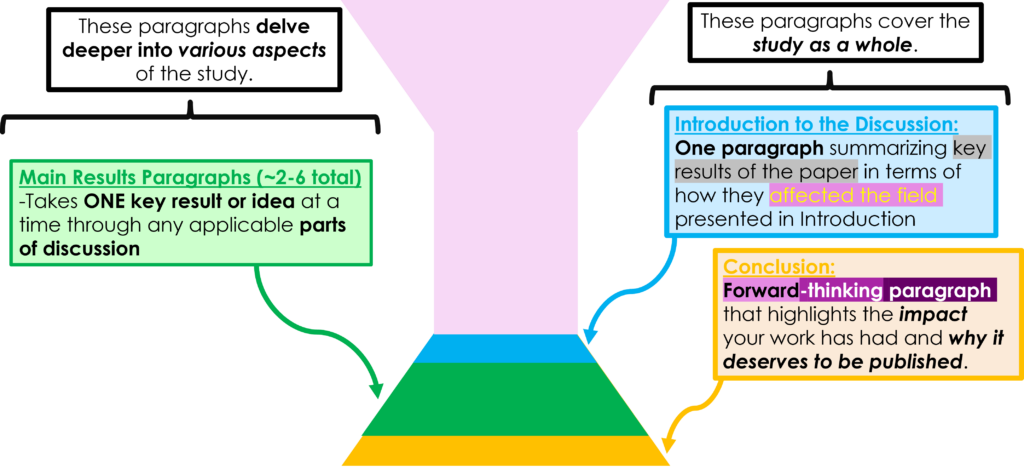
Notice here how we have three types of paragraph (examples below):
- An Intro to the Discussion: One paragraph that summarizes the key results in terms of how they affected the edge of current knowledge as presented in the introduction.
- Main results paragraphs (~2-6): Each paragraph takes one key result or idea from the paper and relates it to all applicable key parts of a discussion.
- Conclusion: One forward-thinking paragraph that highlights the impact of your work and why it deserves to be published.
Also note that the first and last paragraphs of the discussion will relate to the study as a whole, while the middle ones generally delve deeper into various aspects of the study.
Examples of real DISCUSSIONS
Now let’s look into some real discussion sections.
Let’s start with this paper by Lukauskas, S., Tvardovskiy, A., Nguyen, N.V. et al. from Nature (https://doi.org/10.1038/s41586-024-07141-5).
Note first – this is a short discussion, which is perfect as a demonstration though yours may be much longer – not a problem!
Now, notice how this discussion follows the structuring shown above in terms of paragraphs and their ordering.
What colors do you see in each type of paragraph? What might this tell you about the type of information we are conveying in each paragraph?

Introduction to the Discussion
In this first paragraph, the authors summed up the key results of this paper and related them back to the edge of current knowledge at the start of this work.
i.e., They explained to the reader HOW their work AFFECTED the field.
As such, this beginning part of the discussion contains the most summary text – note, it’s NOT saved for the conclusion!
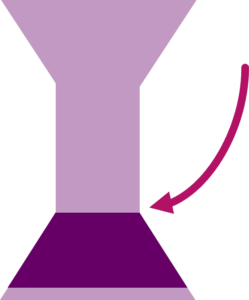
This makes sense, as this part of the discussion should be the narrowest in scope – the reader just finished reading about your work, so this is the perfect place to summarize that.
But don’t forget to include how your work affected the field – this is a key place to indicate the impact of your work and you don’t want to miss it!
Notice also from this first example that the authors mention a number of different statements of how their work affected individual GAPS in their field (pink text in paragraph 1 above).
This is a great way to highlight advances in several areas, as these authors have done well.
In some papers, though, it makes more sense to sum up the body of work as a whole and relate it all back to one big gap that all of this work sought to fill, like in this next figure.
You can see that clearly in this next paragraph, which has more summary text and only one statement of a GAP in pink.

Here, the authors Wen, X., Luo, Z., Zhao, W. et al. (Nature [2024]. https://doi.org/10.1038/s41586-024-07239-w) addressed one major gap in the field with their work, so their first paragraph looks different from the one above.
If you prefer to just quickly and directly state the main result and why it is important or impactful, you could also do that, just as authors Benevento, M., Alpár, A., Gundacker, A. et al. did in their Nature paper, shown below (https://doi.org/10.1038/s41586-024-07232-3).

Again, make this work for you and the specific mix of results and gaps that you have in your paper.
Middle paragraphs (~2-6)
Now let’s move to the middle paragraphs.
In each of these paragraphs, we will take one key result or idea generated from our paper and use any applicable key parts of a discussion that support that point.
For instance, let’s look at this example below of three middle paragraphs taken from the discussion of Montràs-Janer, T., Suggitt, A.J., Fox, R. et al. from Nat Ecol Evol (https://doi.org/10.1038/s41559-024-02326-7).
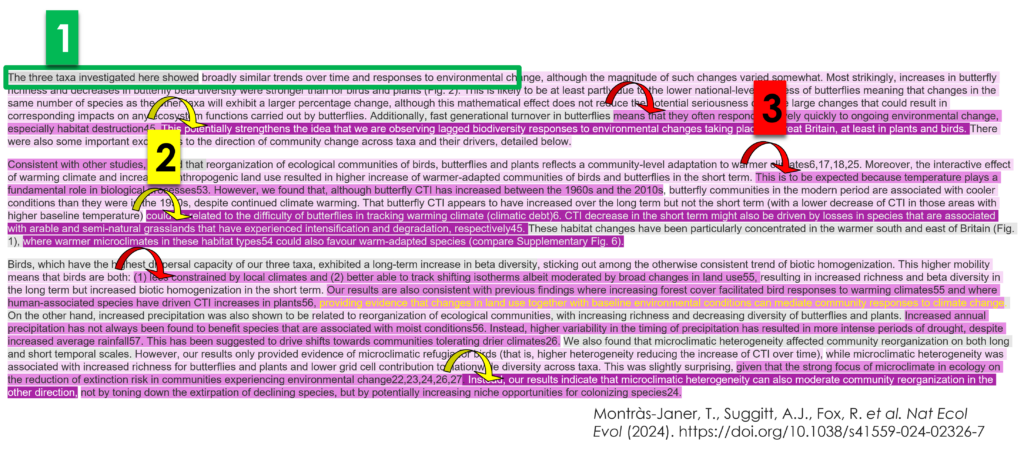
Here, I want you to notice 3 key things about these paragraphs:
- They all start with a summary of results (grey) or an analysis of those results (what they mean, a new hypothesis, etc.) – and not a fact from the field.
This is because this paper is the origin story of YOUR work – so make that the centerpiece.
Think of the hourglass – Start at your work and build out.
It is a mistake to start a paragraph of your discussion with text describing the field, whether a concept, definition, or previous work – more on that in our next post of the 7 biggest discussion mistakes! - After analyzing what your results mean, THEN you can start relating to literature from the field.
Use this to support (or contradict!) your findings and generally paint a picture of how your work fits into the existing body of knowledge.
You can also use these paragraphs to speculate beyond the existing body of knowledge, which shows how your work creates a new edge of current knowledge.
What might your results mean more broadly? How might they have changed or affected the field? What future directions could this work take to address these new ideas (not shown in these paragraphs)?
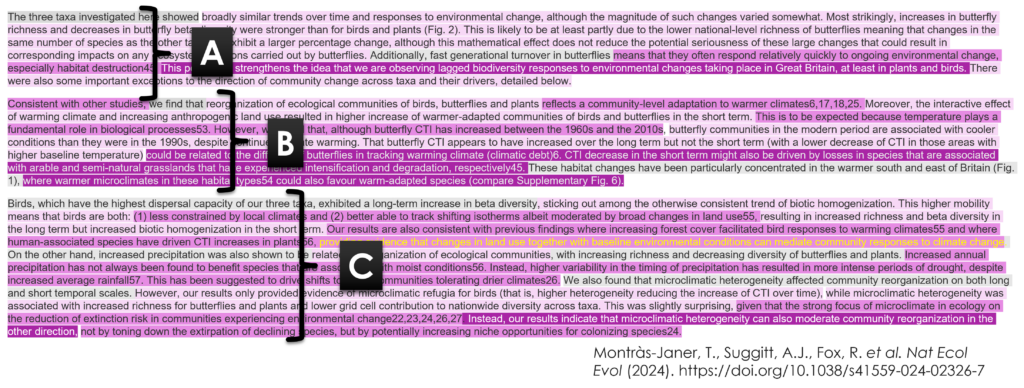
It is clear that each of these paragraphs is composed of different colors (key parts).
Let’s talk about when you’d want to use similar paragraphs in your discussion:
A – skewed to ANALYSIS:
- Give space to justify your interpretation
- Great for explaining interpretation of complex, surprising, unexpected results
- Use paragraphs like this to ensure that your interpretation is clear and justify why you chose this interpretation and not another.
B – balancing ANALYSIS, FIELD, SPECULATION:
- Join result(s) or idea(s) with data from the field and show impact all in one paragraph
- Can add future directions for new work or to address limitations
- Use paragraphs like this as the backbone of your discussion, showing what your various results mean and why they matter.
- When in doubt, PERFECT balanced starting point!
C – skewed to FIELD and GAP:
- Provide support for your findings
- Show how your work fits in with the field
- Use paragraphs like this to demonstrate your place in this field/world

D – Paragraphs skewed to SPECULATION with FIELD:
- Can explore contradictory work in the field (and why the contradiction might exist!)
- Can explain or outline new hypotheses or questions
- Justified with LITERATURE
- Use paragraphs like these to speculate on differences between your results and the field or to justify proposed new hypotheses.
E – Paragraphs skewed to mainly SPECULATION (often with FUTURE DIRECTIONS):
- Discuss the IMPLICATIONS and IMPACT of your work
- What has your work changed about the field?
- Use paragraphs like these to highlight the new edge of current knowledge and your opinions about what, therefore, should be done next.
Overall, these example paragraphs are great starting points, but there are many ways to combine the key parts for a nice discussion paragraph.
Focus here on learning from these examples how the parts of a discussion work together to justify your claims and support your work so that you can best apply them in your own discussion.
Conclusion
By this point in the paper, the reader should be getting excited about our work and its implications, and we want to encourage that by giving them a very forward-thinking paragraph that looks far outside our work by connecting it to the world at large.

This makes sense, as according to our hourglass shape, we want to match the broad scope at the beginning of the introduction.
Thus, for a balanced paper, this final paragraph of the discussion should be the BROADEST in scope.
This definitely means your conclusion shouldn’t be a summary.
To brainstorm possible information to include here, ask yourself:
- What specifically does my research to do advance science?
- What exactly does this bring to the field? How has it advanced the field?
- What can be built/done/made/calculated now that my research exists?
- How can my research be expanded upon in the future?
- Why might other scientists in my field be excited about this? How about non-scientists?
What's next?
Alright – so that’s a discussion!
How do you feel about your discussion now?
More importantly, how do you feel about sitting down to write your next discussion?
If you want more tips on writing a discussion, check back for our next post on the 7 biggest mistakes in a discussion.
